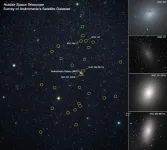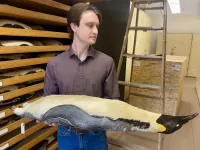(Press-News.org) Located 2.5 million light-years away, the majestic Andromeda galaxy appears to the naked eye as a faint, spindle-shaped object roughly the angular size of the full Moon. What backyard observers don't see is a swarm of nearly three dozen small satellite galaxies circling the Andromeda galaxy, like bees around a hive.
These satellite galaxies represent a rambunctious galactic "ecosystem" that NASA's Hubble Space Telescope is studying in unprecedented detail. This ambitious Hubble Treasury Program used observations from more than a whopping 1,000 Hubble orbits. Hubble's optical stability, clarity, and efficiency made this ambitious survey possible. This work included building a precise 3D mapping of all the dwarf galaxies buzzing around Andromeda and reconstructing how efficiently they formed new stars over the nearly 14 billion years of the universe's lifetime.
In the study published in The Astrophysical Journal, Hubble reveals a markedly different ecosystem from the smaller number of satellite galaxies that circle our Milky Way. This offers forensic clues as to how our Milky Way galaxy and Andromeda have evolved differently over billions of years. Our Milky Way has been relatively placid. But it looks like Andromeda has had a more dynamic history, which was probably affected by a major merger with another big galaxy a few billion years ago. This encounter, and the fact that Andromeda is as much as twice as massive as our Milky Way, could explain its plentiful and diverse dwarf galaxy population.
Surveying the Milky Way's entire satellite system in such a comprehensive way is very challenging because we are embedded inside our galaxy. Nor can it be accomplished for other large galaxies because they are too far away to study the small satellite galaxies in much detail. The nearest galaxy of comparable mass to the Milky Way beyond Andromeda is M81, at nearly 12 million light-years.
This bird's-eye view of Andromeda's satellite system allows us to decipher what drives the evolution of these small galaxies. "We see that the duration for which the satellites can continue forming new stars really depends on how massive they are and on how close they are to the Andromeda galaxy," said lead author Alessandro Savino of the University of California at Berkeley. "It is a clear indication of how small-galaxy growth is disturbed by the influence of a massive galaxy like Andromeda."
"Everything scattered in the Andromeda system is very asymmetric and perturbed. It does appear that something significant happened not too long ago," said principal investigator Daniel Weisz of the University of California at Berkeley. "There's always a tendency to use what we understand in our own galaxy to extrapolate more generally to the other galaxies in the universe. There's always been concerns about whether what we are learning in the Milky Way applies more broadly to other galaxies. Or is there more diversity among external galaxies? Do they have similar properties? Our work has shown that low-mass galaxies in other ecosystems have followed different evolutionary paths than what we know from the Milky Way satellite galaxies."
For example, half of the Andromeda satellite galaxies all seem to be confined to a plane, all orbiting in the same direction. "That's weird. It was actually a total surprise to find the satellites in that configuration and we still don't fully understand why they appear that way," said Weisz.
The brightest companion galaxy to Andromeda is Messier 32 (M32). This is a compact ellipsoidal galaxy that might just be the remnant core of a larger galaxy that collided with Andromeda a few billion years ago. After being gravitationally stripped of gas and some stars, it continued along its orbit. Galaxy M32 contains older stars, but there is evidence it had a flurry of star formation a few billion years ago. In addition to M32, there seems to be a unique population of dwarf galaxies in Andromeda not seen in the Milky Way. They formed most of their stars very early on, but then they didn't stop. They kept forming stars out of a reservoir of gas at a very low rate for a much longer time.
"Star formation really continued to much later times, which is not at all what you would expect for these dwarf galaxies," continued Savino. "This doesn't appear in computer simulations. No one knows what to make of that so far."
"We do find that there is a lot of diversity that needs to be explained in the Andromeda satellite system," added Weisz. "The way things come together matters a lot in understanding this galaxy's history."
Hubble is providing the first set of imaging where astronomers measure the motions of the dwarf galaxies. In another five years Hubble or NASA's James Webb Space Telescope will be able to get the second set of observations, allowing astronomers to do a dynamical reconstruction for all 36 of the dwarf galaxies, which will help astronomers to rewind the motions of the entire Andromeda ecosystem billions of years into the past.
The Hubble Space Telescope has been operating for over three decades and continues to make ground-breaking discoveries that shape our fundamental understanding of the universe. Hubble is a project of international cooperation between NASA and ESA (European Space Agency). NASA's Goddard Space Flight Center in Greenbelt, Maryland, manages the telescope and mission operations. Lockheed Martin Space, based in Denver, also supports mission operations at Goddard. The Space Telescope Science Institute in Baltimore, which is operated by the Association of Universities for Research in Astronomy, conducts Hubble science operations for NASA.
Explore More
NASA’s Hubble Traces Hidden History of Andromeda Galaxy
Hubble’s High-Definition Panoramic View of the Andromeda Galaxy
Explore the Night Sky: Messier 31
Hubble's Galaxies
Follow Hubble's social pages: @NASAHubble @NASAHubble @NASAHubble
Media Contact:
Claire Andreoli (claire.andreoli@nasa.gov)
NASA's Goddard Space Flight Center, Greenbelt, Maryland
Ray Villard
Space Telescope Science Institute, Baltimore, Maryland
Science Contact:
Alessandro Savino
University of California, Berkeley, California
END
NASA’s Hubble provides bird’s-eye view of Andromeda galaxy’s ecosystem
2025-02-27
ELSE PRESS RELEASES FROM THIS DATE:
New ocelot chip makes strides in quantum computing
2025-02-27
Scientists based at the AWS Center for Quantum Computing on Caltech's campus have made a leap forward in figuring out how to suppress errors in quantum computers, a pesky problem that continues to be the greatest hurdle to building the machines of the future.
Quantum computers, which are based on the seemingly magical properties of the quantum realm, hold promise for use in many different fields, including medicine, materials science, cryptography, and fundamental physics. But while today's quantum computers can be useful for ...
Computing leaders propose measures to combat tech-facilitated intimate partner violence, human trafficking, and child exploitation
2025-02-27
The Association for Computing Machinery’s Technology Policy Council (TPC) has announced the publication of “TechBrief: Technology Policy Can Curb Domestic Violence, Human Trafficking, and Crimes Against Children,” a new issue brief which explains how intimate partner violence, human trafficking, and child exploitation are facilitated by computing technologies. The term “tech abuse” pertains to a wide variety of abuse in this context. The ACM policy experts contend that tech abuse is being addressed inconsistently, ...
Sometimes, when competitors collaborate, everybody wins
2025-02-27
CAMBRIDGE, MA – One large metropolis might have several different train systems, from local intercity lines to commuter trains to longer regional lines.
When designing a system of train tracks, stations, and schedules in this network, should rail operators assume each entity operates independently, seeking only to maximize its own revenue? Or that they fully cooperate all the time with a joint plan, putting their own interest aside?
In the real world, neither assumption is very realistic.
Researchers from MIT and ETH Zurich have developed a new planning ...
EU Flagship project DORIAN GRAY to use pioneering AI and avatar technology to uncover links between cardiovascular disease (CVD) and mild cognitive impairment (MCI) to improve healthy ageing and survi
2025-02-27
Key take-aways:
Mild cognitive impairment (MCI) is a stage of decline in cognitive function greater than normal for a person’s age and education, not severe enough to impair daily function – but it can progress.
Around one third of people with cardiovascular disease (CVD) also have MCI, yet MCI is undiagnosed in 50-80% of these cases.
The central aim of the EU’s DORIAN GRAY project is to untangle this MCI-CVD connection, reduce the burden of disease at older ages and prolong survival.
Brescia, Italy – 27 February 2025 – A major new project, DORIAN GRAY, ...
SHEA encourages rescheduling postponed Advisory Committee on Immunization Practices (ACIP) Meeting
2025-02-27
The Advisory Committee on Immunization Practices (ACIP) plays a crucial role in protecting childhood and adult health by developing vaccination recommendations based on scientific evidence. SHEA encourages timely rescheduling of the ACIP’s meeting that was scheduled for February 2025 to ensure patients and healthcare providers are getting the most up to date recommendations based on the latest scientific evidence review regarding vaccination.
The ACIP’s recommendations are foundational to public health, guiding pediatric and adult vaccine schedules that have significantly reduced the prevalence of highly communicable infectious ...
Study proposes a new theoretical framework for understanding complex higher-order networks
2025-02-27
Filippo Radicchi, professor of Informatics at the Luddy School of Informatics, Computing, and Engineering, co-authored a ground-breaking study that could lead to the development of new AI algorithms and new ways to study brain function.
The study, titled “Topology shapes dynamics of higher-order networks,” and published in Nature Physics, proposed a theoretical framework specifically designed for understanding complex higher-order networks. It could lead to breakthroughs ...
Archaeology: Vesuvian ash cloud turned brain to glass
2025-02-27
A unique dark-coloured organic glass, found inside the skull of an individual who died in Herculaneum during the 79 CE Mount Vesuvius eruption, likely formed when they were killed by a very hot but short-lived ash cloud. The conclusion, from research published in Scientific Reports, is based on an analysis of the physical properties of the glass, thought to comprise the fossilised brain of the individual.
Glass rarely occurs naturally due to the specific conditions required for formation. For a substance to become glass, its liquid form must cool fast ...
When birds lose the ability to fly, their bodies change faster than their feathers
2025-02-27
More than 99% of birds can fly. But that still leaves many species that evolved to be flightless, including penguins, ostriches, and kiwi birds. In a new study in the journal Evolution, researchers compared the feathers and bodies of different species of flightless birds and their closest relatives who can still fly. They were able to determine which features change first when birds evolve to be flightless, versus which traits take more time for evolution to alter. These findings help shed light on the evolution of complex traits that lose their original ...
Genetic switch could help control leaf growth in poor soils
2025-02-27
A new study has identified a genetic circuit in plants that controls individual leaf growth and allows the plants to adapt to their environment. The findings could help the development of more drought-resistant crops.
Scientists from the University of Nottingham’s School of Biosciences investigated the growth of maize leaves in plants cultivated in three different soils containing differential amounts of nutrients and water. They found that microbes colonising plant leaves across these soils influence the growth of the leaves independently of the concentration of nutrients and soil properties. The findings have been published ...
Virtual breastfeeding support may expand breastfeeding among new mothers
2025-02-27
Mothers who were given access to virtual breastfeeding support (or telelactation) through a free app tended to report more breastfeeding than peers who did not receive such help, with a more-pronounced effect observed among Black mothers, according to a new RAND study.
Reporting results from the first large trial of telelactation services, researchers found that mothers who were given access to video telelactation services reported slightly higher rates of breastfeeding six months after giving birth, as compared to mothers who did not receive the service.
The ...




